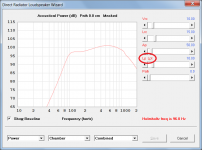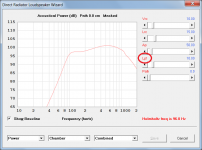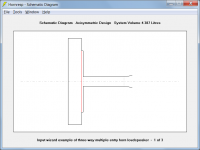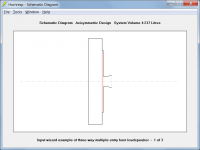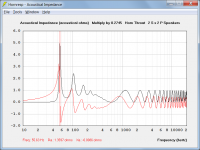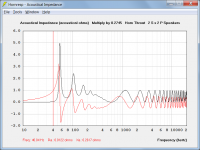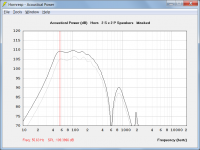Hornresp Update 5050-191121
Hi Everyone,
BUG FIX 1
The Lpt label was shown as Lp Lpt in the Loudspeaker Wizard when it should have been shown simply as Lpt. This has now been fixed. Attachments 1 (before) and 2 (after) refer.
BUG FIX 2
The ME1 and ME2 chamber schematic diagrams in the Multiple Entry Horn wizard were correct but the main schematic diagrams were not. These have now been fixed. Attachments 3 (before) and 4 (after) refer.
Kind regards,
David
Hi Everyone,
BUG FIX 1
The Lpt label was shown as Lp Lpt in the Loudspeaker Wizard when it should have been shown simply as Lpt. This has now been fixed. Attachments 1 (before) and 2 (after) refer.
BUG FIX 2
The ME1 and ME2 chamber schematic diagrams in the Multiple Entry Horn wizard were correct but the main schematic diagrams were not. These have now been fixed. Attachments 3 (before) and 4 (after) refer.
Kind regards,
David
Attachments
Bug-man extraordinaire 
and thanks for the clarifying work regarding Max SPL tool ..
Quick question about excursion...
Since we input RMS voltage, I assume hornresp uses the peak voltage of a sine wave (+3dB) for determining excursion? (and not some other crest factor)
Still working on frequency dependent limiting for prosound...
...just double checking... thx
and thanks for the clarifying work regarding Max SPL tool ..
Quick question about excursion...
Since we input RMS voltage, I assume hornresp uses the peak voltage of a sine wave (+3dB) for determining excursion? (and not some other crest factor)
Still working on frequency dependent limiting for prosound...
...just double checking... thx
Maybe some people can help me out here.
I used to run Hornresp just totally fine a while back under Manjaro Linux Wine with the LC_ALL='C' command.
Since a few weeks I installed Manjaro once again with the newest Wine version and I get an "run-time error '52' " when starting up Hornresp.
Any other people that run into this issue (or at least can replicate) ?
I used to run Hornresp just totally fine a while back under Manjaro Linux Wine with the LC_ALL='C' command.
Since a few weeks I installed Manjaro once again with the newest Wine version and I get an "run-time error '52' " when starting up Hornresp.
Any other people that run into this issue (or at least can replicate) ?
Hi Guys
I'm having a bit of trouble getting my hornresp frequency response graph to match reality closely enough to make design decisions on a project I'm starting. I am trying to simulate a block of 4 punishers sitting on the ground, not next to a wall. Punisher plan is here Punisher Horn MKII
I know from measuring my system with smarrt multiple times that the punishers roll-off at about 40hz. The sim is showing the roll-off at closer to 55hz.
I have tried simming the punishers as both OD and ND but it makes little difference.
You can see all my input parameters and graphs here Help developing Hornresp parameters from plan - Speakerplans.com Forums
I hope linking to my post in another forum is not an issue.
I'm having a bit of trouble getting my hornresp frequency response graph to match reality closely enough to make design decisions on a project I'm starting. I am trying to simulate a block of 4 punishers sitting on the ground, not next to a wall. Punisher plan is here Punisher Horn MKII
I know from measuring my system with smarrt multiple times that the punishers roll-off at about 40hz. The sim is showing the roll-off at closer to 55hz.
I have tried simming the punishers as both OD and ND but it makes little difference.
You can see all my input parameters and graphs here Help developing Hornresp parameters from plan - Speakerplans.com Forums
I hope linking to my post in another forum is not an issue.
Since we input RMS voltage, I assume hornresp uses the peak voltage of a sine wave (+3dB) for determining excursion?
Hi mark100,
The maximum displacement of the driver diaphragm from its mean position is given by:
Dd = Sqrt(2) * Vd / (2 * Pi * f)
Where Vd is the rms velocity of the driver diaphragm at frequency f, and for rms input voltage Eg.
Kind regards,
David
Since a few weeks I installed Manjaro once again with the newest Wine version and I get an "run-time error '52' " when starting up Hornresp.
Hi b_force,
Just to clarify - is the version of Hornresp that no longer works, the same as the one you were successfully using before you updated Wine?
Kind regards,
David
Maybe some people can help me out here.
I used to run Hornresp just totally fine a while back under Manjaro Linux Wine with the LC_ALL='C' command.
Since a few weeks I installed Manjaro once again with the newest Wine version and I get an "run-time error '52' " when starting up Hornresp.
Any other people that run into this issue (or at least can replicate) ?
I'm running Wine 3.0.3 at the moment with the current version of Hornresponse on a Mint machine and it works fine. In fact every version I've run over the last five or six years has worked without problems on whatever version of Mint and Wine I was running at the time. I have no experience with Manjero.
I'm having a bit of trouble getting my hornresp frequency response graph to match reality closely enough to make design decisions on a project I'm starting.
Hi Hugh,
If your simulation model is an accurate representation of the actual physical loudspeaker system, and the driver parameter values are correct, then I have no idea why there should be such a discrepancy between your measured results and the Hornresp predictions.
It is interesting that the Punisher speakers roll-off as low as 40Hz. The predicted 55Hz figure is closer to what I would have expected to see for such a design, which in reality is just a severely foreshortened front-loaded bass horn, resulting in a very peaky throat acoustical impedance loading the front side of the diaphragm.
Attachment 1 shows the acoustical resistance Ra peaking at 55Hz, while Attachment 2 shows that at 40Hz the resistance is very low, which is why I am somewhat surprised at the performance you are achieving.
Kind regards,
David
Attachments
Someone on speakerplans pointed out that my measurements are unlikely to be in true half space, I would agree with this as most of our shows are indoors or close to walls, not in big open fields. Do you think it would be unrealistic to sim in quater space?
That's exactly what I was thinking. I've experienced the same thing when measuring bass horns in rooms. There was a discussion about this on DIYAudio many years ago when I presented my HornsubJr design. That horn was designed to be corner loaded but was obviously getting reinforcement from the ceiling as well. I adjusted the model to reflect the measured performance and many people were up in arms about it. A search might find that discussion.
Do you think it would be unrealistic to sim in quater space?
No, not unrealistic, given the circumstances.
Note however that while simulating the four-speaker array in 1Pi space will increase the predicted output level, it will not noticeably lower the roll-off frequency.
Attachments
Definitely not, that was like a year ago or something.Hi b_force,
Just to clarify - is the version of Hornresp that no longer works, the same as the one you were successfully using before you updated Wine?
Kind regards,
David
I mean, yes there are other ways to run it, but those are all a little inconvenient.
I even tried running it via Steam, which gave me the same issue.
I thought before I am going to post something on the Wine forum, maybe just post it here first.
See what people's experience is in general (since it's not a very popular program, most of the time it will be snowed over on the Wine forums)
I'm running Wine 3.0.3 at the moment with the current version of Hornresponse on a Mint machine and it works fine. In fact every version I've run over the last five or six years has worked without problems on whatever version of Mint and Wine I was running at the time. I have no experience with Manjero.
Running Manjaro with the latest Wine version (since Manjaro has rolling updates)
Which is Wine 4.18 atm. I tried the 32-bit as well as the 64-bit, both weren't able to run properly with the added command.
Without you'll get the already known bug (I think it's the decimal point or comma?)
Technically I could use PlayOnLinux, but I found that program very fiddly to use.
I'm running Wine 3.0.3 at the moment with the current version of Hornresponse on a Mint machine and it works fine. In fact every version I've run over the last five or six years has worked without problems on whatever version of Mint and Wine I was running at the time. I have no experience with Manjero.
That sounds really good. And in character for Mint. My experience with hornresp, wine and various flavours of Ubuntu has been mixed. It's clear that hornresp *can* work fine with wine, but you need the right versions and modules. Which some distros have and others not etc.
Last edited:
That sounds really good. And in character for Mint. My experience with hornresp, wine and various flavours of Ubuntu has been mixed. It's clear that hornresp *can* work fine with wine, but you need the right versions and modules. Which some distros have and others not etc.
Ok, so I just tried this.
Installed PlayOnLinux with Wine version 3.0.3 (32-bit), had to install the corefonts as well (important as well, I had to install them manually with the shell
Now with some fiddling, I managed to run Hornresp totally fine with the following command;
LC_ALL=C playonlinux --run Hornresp
Or if you're using the Whisker Menu, make a shortcut with the command;
env LC_ALL=C playonlinux --run Hornresp
(the "env" part is important here, otherwise it won't run)
Absolutely no clue why the newer wine version refuses to run something simple as Hornresp
Someone on speakerplans pointed out that my measurements are unlikely to be in true half space, I would agree with this as most of our shows are indoors or close to walls, not in big open fields.
Are you saying that your measurements were done indoors?
If so, then perhaps room resonances could be the reason for the differences between the measured and predicted low frequency results.
- Home
- Loudspeakers
- Subwoofers
- Hornresp
